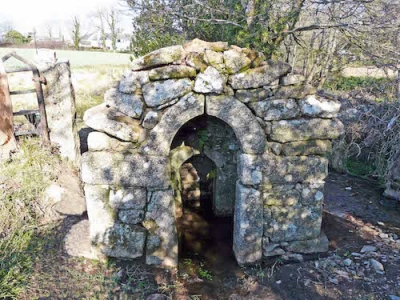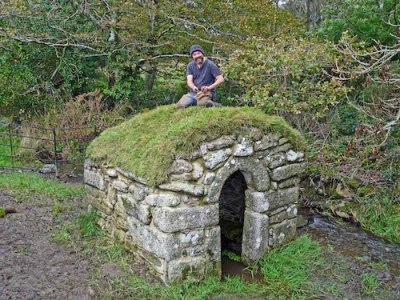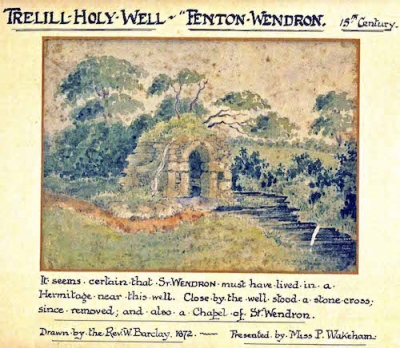 A team of experts with a variety of expertise largely disconnected from the restoration of holy wells and mostly, though not exclusively, members of the Meneage Archaeological Group (MAG) assembled on occasions during the last three years in a boggy corner of a field at Trelill Farm. It seems an odd place to house a spring, welling up less than five yards from a flowing stream which suggests the building was an emphasis added to an established tradition of reverence for that spot.
A team of experts with a variety of expertise largely disconnected from the restoration of holy wells and mostly, though not exclusively, members of the Meneage Archaeological Group (MAG) assembled on occasions during the last three years in a boggy corner of a field at Trelill Farm. It seems an odd place to house a spring, welling up less than five yards from a flowing stream which suggests the building was an emphasis added to an established tradition of reverence for that spot.
Similar structures may be visited throughout Cornwall and farther afield. They sometimes give the impression of being erected by amateurs such as us, cobbled together from architectural elements freed by nearby demolition (Davidstow has a six foot square granite cross base masquerading as a roof member).
Here at Trelill the two curved segments of the entry arch, atop the durns, are a near mismatch, one elbowing an overlong quoin proud of the wall line; protruding foundations would be happier with a fifteen degree clockwise rotation of the building; and the roof, before serious attention from some real experts, needed the eye of faith to hold up the sky.
 In keeping with many holy wells pins were required as offerings. Use by piskies instead of hawthorn tips to their arrows has been suggested, psychosomatic indulgences being taken in return. Some wells had appetites for crooked pins carrying forward traditions of casting new weapons, mangled beyond use, into watery places. St Warna’s on the Isles of Scilly exchanges shipwreck for properly distorted pins.
In keeping with many holy wells pins were required as offerings. Use by piskies instead of hawthorn tips to their arrows has been suggested, psychosomatic indulgences being taken in return. Some wells had appetites for crooked pins carrying forward traditions of casting new weapons, mangled beyond use, into watery places. St Warna’s on the Isles of Scilly exchanges shipwreck for properly distorted pins.
Trelill seems benignly mysterious, offering no remembered curative properties. Along with the majority, a female saint has been allotted its guardianship. Wendrona also has care of Wendron church and, on shakier ground than the marshland, just possibly Vendrónukirkja in Iceland.
In AD1208 Eglosiga is recorded at Wendron. Six centuries later the stream by which Trelill Holy Well abides is noted as Dour Iga. If Iga was a saint, nothing is known of her – about the same as Wendrona.
Three words of Cornish: dour, water; eglos, church; durn, door post.

Trelill Holy Well can be found a short walk from a dedicated car park south of the road at Trelill and is signed or will be in the very near future. It was Cornwall’s first Scheduled Monument (and is accordingly titled Scheduled Monument Cornwall No. 1) and the recent sterling work, watchfully and energetically overseen by Ann Preston-Jones and James Gossip of HES, has removed it from the Monuments at Risk register. Thanks to Mark Rowe the landowner for financial and practical support.
References:
Trelill Holy Well, Cornwall; Archaeological Building Survey; Ann Preston-Jones, Jo Sturgess; Cornwall Archaeological Unit; March 2003
Trelill Holy Well, Helston, Cornwall; Conservation and Restoration; Ann Preston-Jones; Cornwall Council 2014
Published: Mar 2015
Author: Chris Harris, a member of MAG
